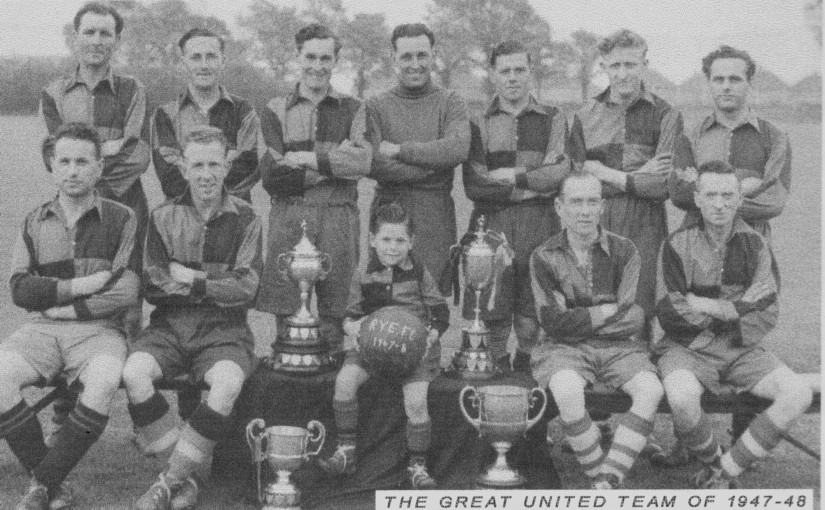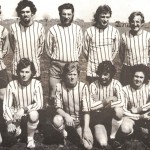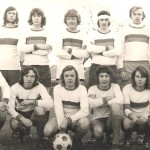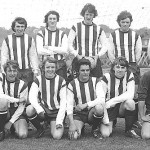Football, the soccer variety, captured the imagination of the people of Rye well before the turn of the 19th. Century. There were doubtless many teams playing the old ‘kick and rush’ style of football in Rye and the surrounding districts in the days of the great Corinthians and Wanderers – but legend only tells the story of pre-1900 soccer matches played in the Town.
The Outstanding Rye Team of 1904
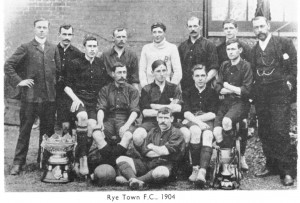
1904 saw the first success recorded in the new century. In that year the Rye Football Club carried off the Tunbndge Wells Charity Cup in front of capacity crowds at the Central Ground, Hastings. That evening the victorious team was welcomed at Rye Station by hundreds of enthusiastic supporters who had been unable to get tickets for the match. The Rye Town Band played “Sussex By The Sea” as the great team, captained by J.H.Gasson, was carried shoulder high by the Fire Brigade to the rostrum where the Mayor and Councillors awaited to add their congratulations to those of the people. A procession around the streets followed, the cup held high for all to see. If it had been the F.A.Cup these eleven heroes could not have commanded greater acclaim. The names of W. H. Donovan; A. Rhodes; F. Boreham; F. Phillips; A. Adams; W. Smith; H. Plews, J. Adams; S. Sellman; and E. J. Young along with that of J. H. Gasson are indelible in the history of Rye Sport.
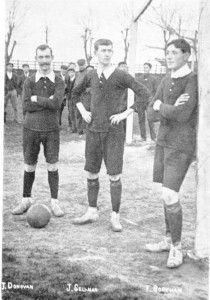
‘Jokey’ Rhodes was the Camber Tram Driver
One of the great characters of Rye Football Club was Edward Rhodes, better known as ‘Jokey’ Rhodes. When the team had away matches, ‘Jokey’, who worked on the Camber Tram, used to “knock off’ at eleven and rush to Rye Station to board the special train hired by the team. On many occasions he was late but the Station Master always held up the train until his arrival.
Rye Football Club ran a reserve team and a picture of the 1911-12 seasons players shows them with a cup won in that year. John Bennett, father of ‘Shoey’ Bennett, later to become legendary in the post Second War Rye United Team for playing the second half of an important match with a broken leg, is in the photograph.
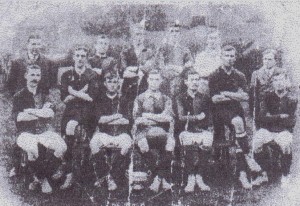
Another successful soccer club in Rye was the St. Mary’s Club, formed by the Rev. Laucher at the beginning of the century. 1904 saw them winning the Rye & District Junior Charity Cup. In the years 1904-14 they played many friendly games with teams from far and near including Newhaven, Bexhill, Lydd Garrison and East Grinstead. Their greatest achievement in this period was in winning the Sussex Junior Cup in 1914.
Rother Invicta, a team from the Rother Ironworks, shared the Town Salts with Rye Football Club in the years prior to the start of the Great War in 1914 when football activity in the area came to a close for the duration save for a few games played between service teams. Some of the great names in Rye football went off to fight a war from which many would not to return.
THE TOLL OF THE WAR
After the terrible carnage of the ‘Great War to save humanity’ the survivors returned home to rebuild their rudely interrupted lives and get back to their sports and interests. The Rye Football Club restarted but the only old faces to rejoin were Arthur Adams and Jimmy Selman. The Club was a mere shadow of its former self but played on into the early thirties until it finally amalgamated with the Rye Old Boys F.C. , a very strong and enthusiastic Club, formed by school master Sidney Allnutt, to give lads leaving school a chance to carry on playing in those times when there were no minor leagues.
The St. Mary’s team, in contrast to that of Rye F.C., reformed in 1919 and regained all its old glories, winning the Sussex Junior Cup in 1921,22,23,26,29 and 1931.
A new club was soon to take the field and bring victories to the Town that were undreamed of in those early days. Instead of having several clubs all with two or three good players why not have one club fielding several teams, graded according to abilities? These were the thoughts of several soccer loving Rye officials in the thirties. Their ideas became a reality and Rye United Football Club was born and to this day remains one of the foremost clubs in the area. Rye United became a forced to be reckoned with by the end of the thirties when, as with its illustrious predecessor Rye F.C., its activities were interrupted by a World War. Unlike the first occasion however most of the Rye team returned from this conflict to take up where they left off. In fact the period from 1947- 52 was a

halcyon spell in the Club’s history. They swept all before them, winning trophy after trophy, year after year. Those who followed the team through this purple period will not forget the great evenings at the Pilot Field when nail biting finals were fought out, many going into extra time against the best Hastings and other Sussex teams.
The names of Fred Masters; Bert Weller; Pickles’ Jgglesden: Ted Southerden; ‘Shoey’ Bennett; Bill ‘Blower’ Pierce; Micheal Lehey; Pope and Goodsell; must join the Rye Football Hall of Fame along with that of J. H. Gasson and his team of 1904.
In those years after the War Rye United played on the Town Salts where all the top Rye teams had played in the past. Spectators often sat on the metal fence on the road side of the pitch. This Ground was the home of Rye Football, the area was almost surrounded by banks which made the perfect natural ‘stands’. All spectators had a good view of the pitch. Unfortunately it was not possible to make a charge to watch the game as the Town Salts were left as a public ground available to all at all times.
When Rye joined the Sussex County League in the Fifties it became a requirement of entry to have an enclosed ground and so the Cricket Salts became the new match venue for United. A small Grand Stand was built but a lot of the atmosphere of the old pitch seemed to be missing and because of the better quality of teams in this higher League, United did not emulate the countless successes of the golden years that proceeded entry into the County League.
Rye’s finest achievement in their 25 years or so in the Sussex County League was a runners up spot to Chichester in the 1959-60 season.
During the immediate post war years the policy of one club running several teams was continued, except for Rye Casuals who played on the Cricket Salts in the late forties. They wore a Blue & Gold quartered strip and were possibly made up of Rye Grammar School Old Boys.
In 1966 England won the World Cup and interest in soccer climbed to new heights. Village teams were inundated with new players. Udimore, Brede, Peas-marsh, East Guildeford, Icklesham, Wittersham, Appledore all had strong teams, Iden formed a team and soon had a reserve team. Udimore found enough players to field two teams, Jcklesham ran three, many Rye lads joined these sides as United were unable to accommodate more than the three sides they already ran on the pitches at their disposal.
Rye Athletic was Born
Terry Lane introduced the first works side in Rye since the days of Rother Invicta when he instigated the Rickett & Coleman side with the company who provided the kit and equipment. The team used the New Road School pitch and soon became a force to be reckoned with in the Hastings League. When the Reckett & Coleman Company left Rye the lads decided to form a new club and Rye Athletic was born.
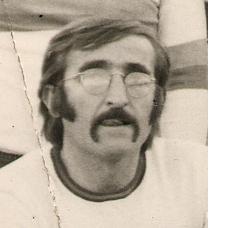
Athletic, under the guidance of Physical Training Instructor Terry Spencer were successful, winning Division Three of the Hastings League. They were soon running two teams and eventually reached Division One. They changed their venue and made the Town Salts their home but as the euphoria of the England World Cup victory began to fade over the years, so too the new surge of soccer activity. Athletic went down to one team, then none as did Udimore. East Guildeford are no more. Iden are the exceptions, going on to greater things and even challenging Rye United over recent years in the Kent League.
SUNDAY SOCCER COMES TO RYE
A new kind of football team sprang up in the seventies. The Sunday League made up in great part by pub sides. There were several in Rye, the most successful being the Crown team. These teams drew their players from Saturday League sides and were often a hotch potch of good, mediocre and low grade players. Some of the matches were of a good quality but on the whole the games were not taken as seriously as Saturday matches. The Crown still runs a team but home matches are all played in Hastings now.
RYE UNITED IN PREMIER DIVISION
Rye United run only two teams now, in the Premier and Second Divisions of the British Energy Kent Football League League. They were placed second in the Premier Division last season and even after a poor start to the 1999-2000 season they are placed in the top half of the table at the present time.
Manager Brian Collins runs the team and featured players of recent times are Moth, Bennett, Wall, Nunn, Kewley, Ruddy’ Stanley, Neater, Carey, Scott, O’Callaghan, Loft and Price.
Perhaps the Red & Black shirts of Rye wilt storm to triumph in the new millennium and emulate the great teams of 1906 and the late forties. Could there be another J.H.Gasson or Blower Pierce lurking in the Rye side of 2000. Get down to the Salts on a Saturday afternoon and cheer them on.
Published in the Millennium issue of “Rye’s Own” January 2000
